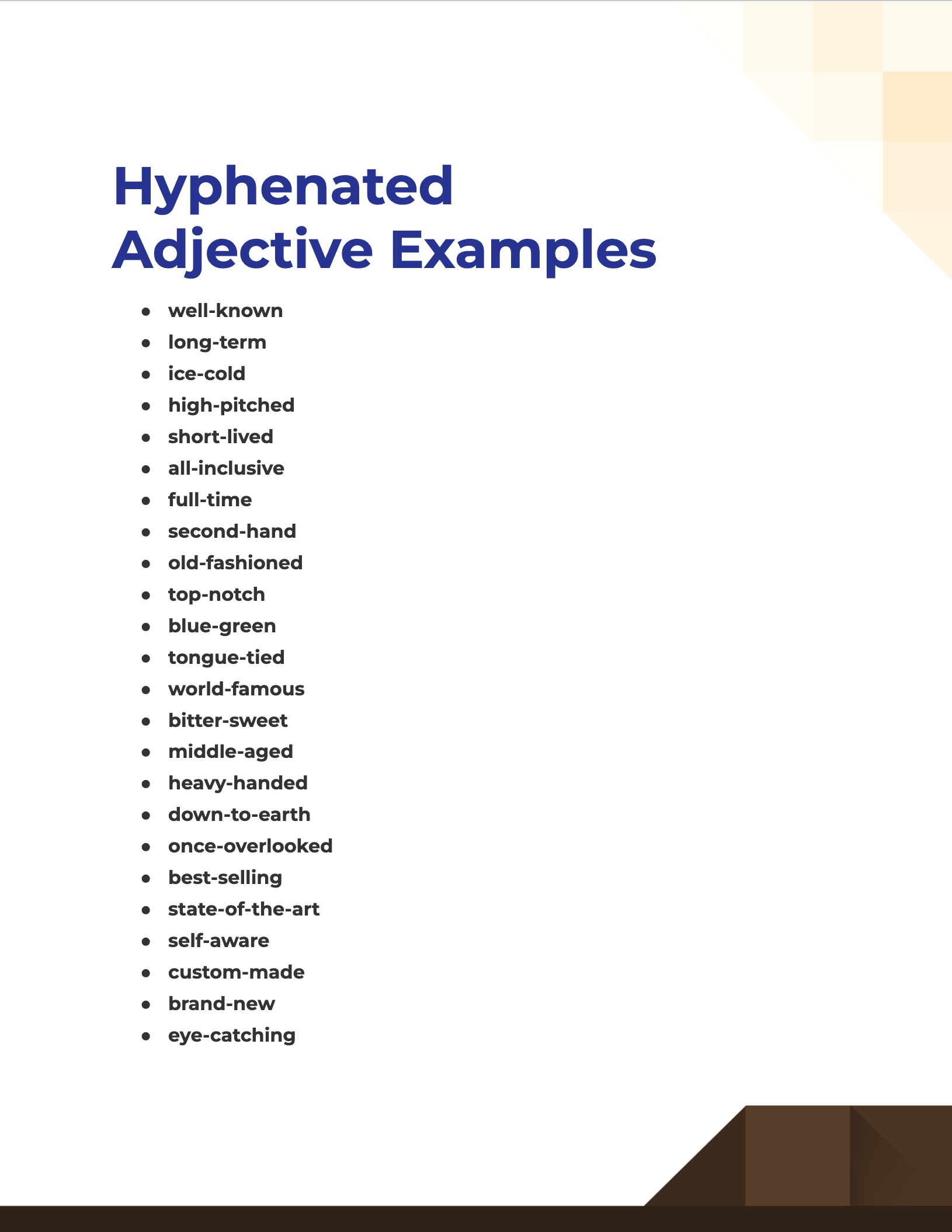99+ Hyphenated Adjective Examples
Dive into the dynamic world of hyphenated adjectives and explore how they can transform your writing. These composite descriptors, stitched together with hyphens, add zest and clarity to sentences and adjective examples. From mastering their structure to discovering their impact, our guide unfolds the secrets of these compelling grammatical wonders.
What is the Hyphenated Adjective? – Definition
A hyphenated adjective is a compound adjective made up of two or more words joined together by a hyphen. This union helps avoid ambiguity and clarifies the description, ensuring that the words function as a single descriptive unit in a sentence.
What is the best Example of a Hyphenated Adjective?
One classic example of a hyphenated adjective is “well-known”. In the sentence, “She is a well-known author,” the hyphenated adjective “well-known” describes the noun “author”. Without the hyphen, the meaning might shift, implying perhaps that she is well and known, rather than widely recognized.
100 Hyphenated Adjective Examples

Unlock a treasure trove of vibrant hyphenated adjectives that can elevate your prose. These unique descriptors, seamlessly linked with hyphens, are key players in delivering crisp, nuanced messages. Below, explore a curated list of hyphenated adjectives ready to enrich your linguistic palette.
- well-known
- long-term
- ice-cold
- high-pitched
- short-lived
- all-inclusive
- full-time
- second-hand
- old-fashioned
- top-notch
- blue-green
- tongue-tied
- world-famous
- bitter-sweet
- middle-aged
- heavy-handed
- down-to-earth
- once-overlooked
- best-selling
- state-of-the-art
- self-aware
- custom-made
- brand-new
- eye-catching
- sugar-free
- last-minute
- easy-going
- double-edged
- little-known
- wide-eyed
- paper-thin
- quick-witted
- heartfelt
- tight-knit
- warm-hearted
- old-world
- jet-black
- fast-paced
- ill-advised
- rock-solid
- tongue-in-cheek
- one-sided
- much-needed
- sun-drenched
- top-tier
- water-resistant
- hard-headed
- well-worn
- mass-produced
- full-blown
- ever-present
- first-rate
- hands-free
- bright-eyed
- all-out
- five-year-old (as in a five-year-old child)
- razor-sharp
- fair-minded
- half-hearted
- barefooted
- user-friendly
- thirty-foot-long
- fun-loving
- hard-to-find
- mouth-watering
- time-sensitive
- far-reaching
- cash-strapped
- whisper-quiet
- pencil-thin
- pitch-dark
- stress-free
- never-ending
- hard-to-please
- deep-seated
- run-of-the-mill
- broken-hearted
- iron-clad
- strong-willed
- light-footed
- daredevil
- up-to-date
- four-door
- high-end
- left-handed
- once-in-a-lifetime
- far-fetched
- thought-provoking
- wide-ranging
- spine-chilling
Benefits of Using Hyphenated Adjectives
- Precision: Hyphenated adjectives can offer a more specific description than single-word adjectives. For instance, “world-class” gives a higher caliber of excellence than merely “good” or “excellent”.
- Avoiding Ambiguity: The hyphen ensures that the two words are interpreted as a single descriptor, preventing potential confusion. “A man eating shark” and “a man-eating shark” convey very different meanings!
- Creativity: Crafting hyphenated adjectives can be an exercise in creativity. They can be especially useful in poetic or creative writing to conjure vivid, memorable imagery.
Common Mistakes to Avoid
- Overusing: While they’re a great tool, it’s possible to overuse hyphenated adjectives, making writing seem cluttered. Balance is key.
- Unnecessary Hyphens: Not every adjective pair requires a hyphen. For instance, “bright yellow shirt” doesn’t need a hyphen between “bright” and “yellow”.
- Redundancies: Some adjectives don’t need an added descriptor. Be wary of combinations that sound repetitive.
Expanding Your Usage
As with any grammatical tool, the key to mastering hyphenated adjectives is practice. Engage in writing exercises, play around with combinations, and read widely. Notice how established writers utilize them and try to emulate their techniques in your work.
It’s also beneficial to seek feedback. Sharing your writing with peers, mentors, or writing groups can offer insights into your effective and ineffective uses of hyphenated adjectives. With time and persistence, you’ll find that these compound descriptors can become an invaluable tool in your writer’s toolkit, helping you craft nuanced, precise, and engaging prose.
Why are adjectives hyphenated?
Hyphenated adjectives, often termed as compound adjectives, are used to combine two or more words to describe a noun more precisely. The hyphen ensures clarity and prevents ambiguity. For example, consider the phrase “a high school student.” Without the hyphen, it could mean a student who is high or a student attending high school. The correct form, “a high-school student,” makes the intent clear.
When not to use a hyphen for adjectives?
- After Adverbs Ending in -ly: If an adverb ending in -ly is paired with an adjective, don’t use a hyphen. Example: “a finely tuned instrument” (not “finely-tuned”).
- Common Combinations: Some adjective pairs are so commonly used together that they don’t need a hyphen for clarity. Example: “a cold winter morning.”
- After the Noun: If the compound adjective comes after the noun, often you won’t need a hyphen. For instance, while you’d write “a blue-eyed girl,” you’d usually write “the girl is blue eyed” without the hyphen.
- With “Very” or Adjective Degrees: Don’t hyphenate compounds made up with “very” or adjectives that show degrees, like “more,” “most,” “less.” Example: “a very well known artist” or “the most up to date technology.”
Do you hyphenate adjectives or adverbs?
Hyphenation usually pertains to compound adjectives, not standalone adverbs. However, there are scenarios where an adverb and adjective might be hyphenated:
- When the adverb doesn’t end in -ly and modifies an adjective: An example would be “a much-loved teacher.”
- To prevent ambiguity: For instance, “more-important issues” vs. “more important issues.” The first indicates that the issues are more important than something else, while the latter suggests there are other issues that are important.
However, as stated earlier, adverbs ending in -ly aren’t usually hyphenated when paired with another adjective: “a quickly moving car” (not “quickly-moving car”).
It’s essential to be aware of these rules, but remember that language is ever-evolving. Always refer to contemporary style guides and stay updated with changing norms.
What is the difference between a dash and a hyphen?
- Appearance & Length:
- Hyphen (-): Shorter in length and is typically used to connect words (as in compound words) or to split a word at the end of a line.
- Dash (—): Longer than a hyphen, specifically called an “em dash”. It’s used to denote a pause, similar to parentheses or commas, or to indicate a range, as in “pages 10—20”.
- Usage:
- Hyphen:
- Combines compound words: “mother-in-law”, “long-term”.
- Splits words at the end of a line.
- Dash:
- Indicates sudden breaks or shifts in thought: “She was walking her dog—at least, that’s what I thought it was—when it started to rain.”
- Sets off parenthetical information: “The conference—which I’m looking forward to—is next week.”
- Notes a span or range: “June—August”, “Pages 45—67”.
- Hyphen:
- Keyboard Input:
- Hyphen: Directly accessible on standard keyboards.
- Dash: On many systems, you can create an em dash by holding down the ‘Alt’ key and typing ‘0151’.
Exercises to Perfect in Hyphenated Adjective:
- Sentence Completion: Fill in the blanks with suitable hyphenated adjectives.
- Sentence Correction: Identify and correct improperly hyphenated adjectives.
- Grouping: Group together words that can form a hyphenated adjective.
- Conversion: Convert a descriptive phrase into a hyphenated adjective. E.g., “a dress that is knee length” becomes “a knee-length dress”.
How to Practice Hyphenated Adjectives?
- Daily Writing Prompts: Dedicate a few minutes daily to write sentences or short paragraphs using hyphenated adjectives.
- Read Widely: Magazines, newspapers, and well-edited books often use hyphenated adjectives correctly. This can offer context and understanding.
- Flashcards: Write the hyphenated adjective on one side and its meaning or a sentence using it on the other.
- Peer Review: Share your writing with peers or writing groups and ask them to identify your usage of hyphenated adjectives.
- Online Quizzes: There are many grammar quizzes online that focus on compound and hyphenated adjectives. This gives immediate feedback and allows for consistent practice.
Regular practice, combined with feedback and correction, will ensure that you master the usage of hyphenated adjectives in no time!
How to Use a Hyphenated Adjective? – Step by Step Guide
- Identify the Need: Before using a hyphenated adjective, determine if the two words you’re combining provide a clearer meaning together than when used separately. For instance, “a well-known actor” requires the hyphen to convey the intended meaning.
- Check Word Order: Typically, the adjective comes before the noun it modifies. “A dark-green dress” is correct, whereas “A dress that is dark-green” isn’t standard.
- Avoid Hyphen Overuse: If you’re combining an adverb that ends in -ly with an adjective, you usually don’t need a hyphen. For example, “a rapidly growing industry” doesn’t need a hyphen.
- Noun Position Matters: If the compound adjective comes after the noun, it often doesn’t require a hyphen. While “a blue-eyed girl” is correct, “the girl is blue eyed” doesn’t need the hyphen.
- Consult a Dictionary: If you’re unsure about a particular compound adjective, refer to a reliable dictionary. Many dictionaries will list common hyphenated adjectives.
- Stay Updated with Style Guides: Different style guides, like AP or Chicago, may have slightly varying rules about hyphenated adjectives. Always refer to the style guide relevant to your writing.
Tips for Using Hyphenated Adjective
- Maintain Clarity: The primary purpose of a hyphen in compound adjectives is to provide clarity. If your sentence reads clearer without the hyphen, consider omitting it.
- Be Consistent: If you use a hyphenated adjective once in a piece, maintain that usage throughout the entire document.
- Tread Carefully with Numbers: When using numbers with other words as adjectives before a noun, always hyphenate. Example: “a 10-year-old boy.”
- Review and Edit: After drafting your writing, re-read it to ensure all hyphenated adjectives are used correctly. This also helps in spotting any inconsistencies.
- Stay Informed: Language is ever-evolving. What’s acceptable today might change tomorrow. Keep abreast of changes by referring to updated style guides and dictionaries.
- Seek Feedback: Share your writing with peers or mentors. They might spot errors or inconsistencies that you’ve overlooked.
By understanding the purpose and rules surrounding hyphenated adjectives, and through consistent practice, you’ll be able to use them effectively and enhance the clarity and precision of your writing.



